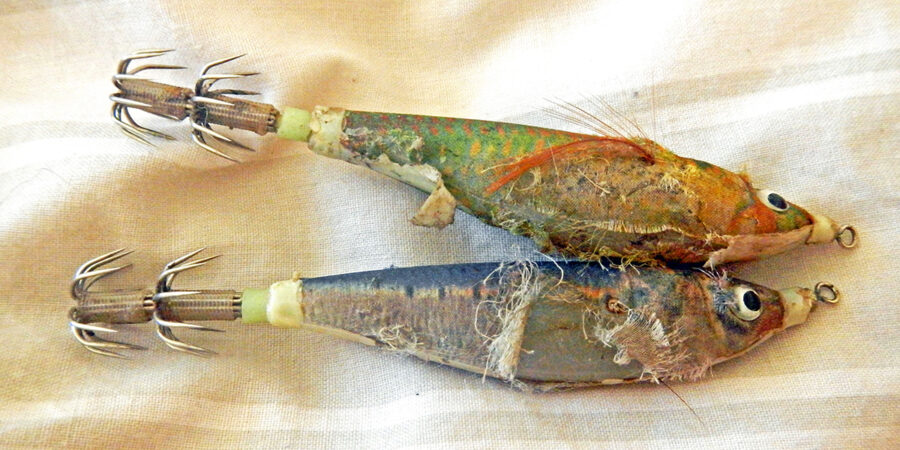Phil Lockley recalls mistakes-a-plenty.
I hope that hints given here may shorten your learning curve; either on technique or from using the wrong gear. On many days I have lost money by making unnecessary mistakes. Buying ‘cheap’ gear is the most expensive mistake you will ever make.
Above: Squid attack from underneath – these are the two lower jigs from a trace – cloth-covered Yamashita Toto Sutte Naturals. Even though they look in poor shape they will still fish.
At first, the shrimp-type jigs that I used were quite expensive, £5 and almost double that per jig, and only in hindsight was that the right thing to do.
At first, I didn’t work out the skills necessary in drifting over rocky ground and I didn’t keep changing depths as I passed over that rock. It’s no use finding the highest peak and setting the line just above that, as I did. Squid strike upward, and sometimes hug the ground, hiding between rocks or in the weed, etc. Your jigs should move with the change in depth. Don’t worry about squid feeding higher and that the jigs are below them. Slow pulls upward, five fathoms at a time and then down again, together with the height of the trace being six fathoms (one fathom between six jigs), and you should have all the effective zones covered.
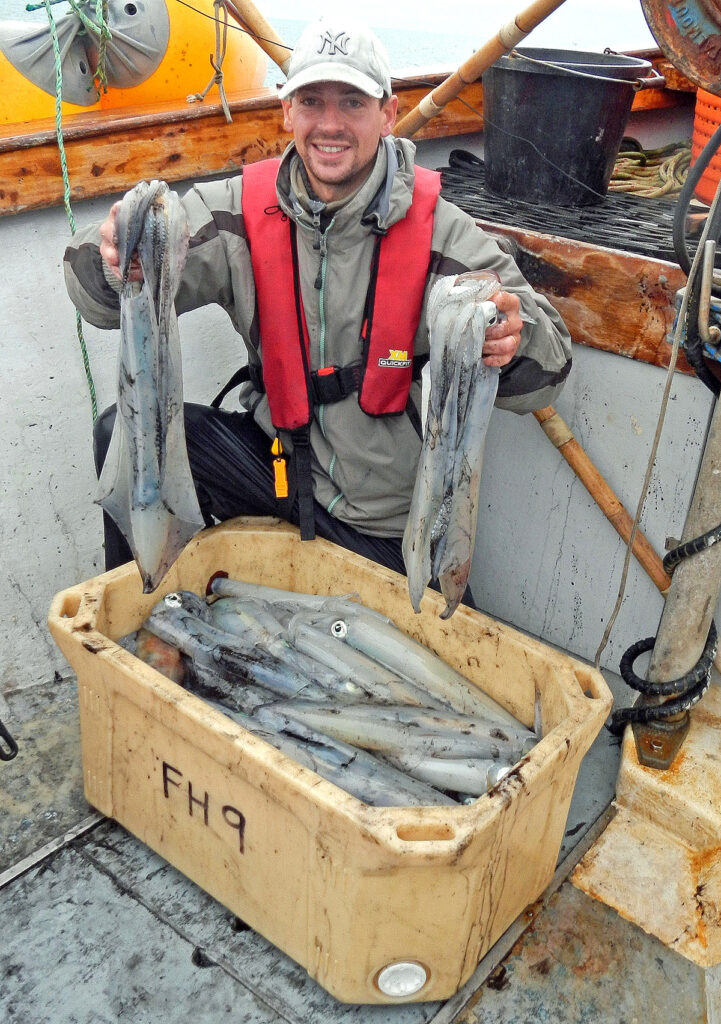
Taimor Jolly with a typical catch of ours on a ‘normal’ day in the early winter of 2013. That squid may not look exactly like that when being landed – but it had better be close!
Ups and downs
On my first visit to an area, to see the peaks and troughs well before the hitch, pulsing to the port side I have my sounder (a Furuno FCV 587), set on dual frequency. That’s OK, but what happens when you get a squid on one line and you are still drifting? The seabed rises and there are plenty of hitches available. What happens to the other line? You can alter the depth, but boy have you got to be fast; you have squid on ‘your’ line. It is all very difficult to balance your actions. You can’t do two jobs at once. And even with a break-free line to the lead, losing jigs is all too common when fishing two lines over unknown ground. On places like that, until you have a good ‘plan’ in your head, and hitches clearly marked on your track plotter, pull one line to half-depth, or even to the top, as an attractor to other squid that may be following the ones on your line.
On days without choosing that option, finding seabed where I knew there were squid ‘zones’, and hence losing jigs at £5 or more per time, became daunting. So I bought cheaper jigs; jigs not made in Japan or jigs being made under the quality control of the major Japanese firms, but which were made in China.
False economy
Armed with the cheaper jigs one night, fishing in a favoured spot, I knew it was the start of a hit. Both poles were going mad, but as I hauled one trace to the surface, there was nothing, and the same with the other line. Back down they went. The shot cord was going mad again, then again, nothing when hauled. Thinking it was just mackerel messing about with the gear, I hauled the lines aboard to move. I KNEW it wasn’t mackerel. It was dark; it was pitch-black, but on closer inspection in the deck light, not one cluster of hooks was still attached to those cheap jigs – all but one in 12 jigs had literally fallen apart. I had lost a lot of money. A hit can be worth hundreds of pounds.
Returning home in a foul mood, I looked at the other 40 or so cheap jigs that I had bought and which were held in my store. I grabbed a pair of long-nosed pliers and tried each jig by pulling the hooks, and with a light pull many fell apart. They were rubbish. Cut a jig lengthwise and you will see that there is no connection between the front eye and the rear hooks, but both are glued-in or set in place while the jigs are being made. The same applies to both shrimp-like jigs and fish-like jigs.
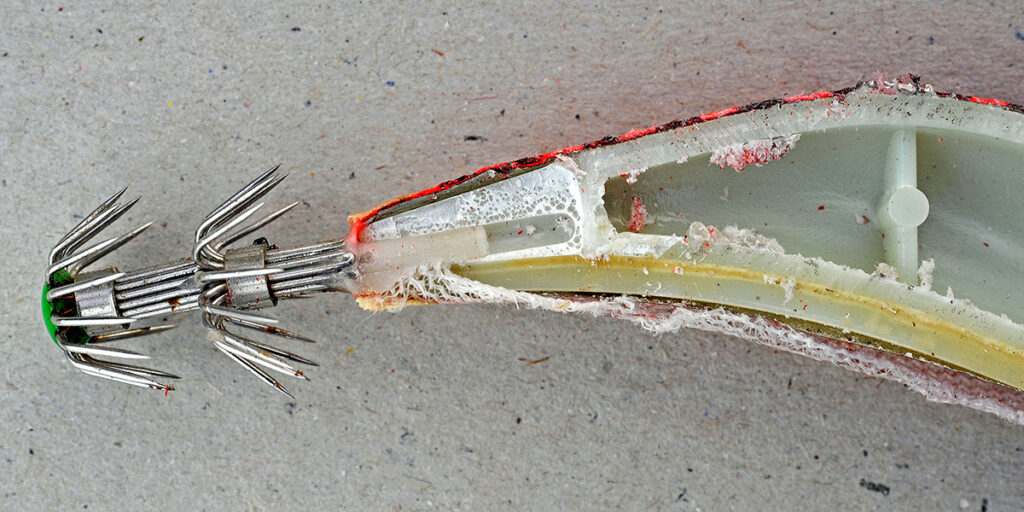
No squid jig has a wire connection between both ends, so careful handling is necessary. These are not commercial jigs but the best brands are incredibly strong.
Something else I discovered on a diving holiday to the Red Sea, shrimp-like jigs are deadly, and were readily available in the shop at Sharm El Sheikh. I bought a couple but soon discovered that a shrimp-like jig should only be used as a single jig. They are aimed at the angling market; the leisure side of squid jigging around the world is enormous, and would throw our UK angling industry into insignificance.
The cook on our dive boat was a keen squid angler. He rumbled around in a drawer, got out a broken jig and further broke it apart for me to see that indeed, there is no through-wire; he also explained about the keel. That weight is judged similarly to a line-weight in fly-fishing; its number depends upon the strength or weakness of line or rod that you intend to use. Further, with shrimp-like jigs the weight is to balance the jig. The jig should fall very slowly but nose down – that type of jig is made for sink and draw.
Life-like jiggle
However, with a fish-like jig it can be used as a single or in a multi-jig trace, but whatever the choice it must remain neutrally buoyant and lie horizontal. To do so, many are weighted accordingly, with the weight inaccessible and placed inside the jig on manufacture. It is the jigging that gives those fish-action jigs their life-like action. Try putting a cheap fish-like jig in a bowl of water – salt water, because no jig is weighted for fresh water – and the cheap jig acts nothing like a fish. Now try a Zo-Zuri, a Yamashita, or a DTD jig, and it will lie exactly like a fish, even the slightest movement makes it ‘jiggle’ like a small fish. Sometimes, when I fish at anchor, that trace looks every bit like a shoal of wee fish, not a washing line with the fish hanging down.
At present, I use very few shrimp-like jigs, however, now living in Australia, a pal of mine Dr Taimor Jolly from France – a marine biologist of note – continues to swear by shrimp-like jigs, and he is one of the best squid catchers I know. Working as a scientist, marine biology took second place when Taimor was aboard Amanda J. He and I worked as a squid-team for two years. On the days when I had to stay ashore, Taimor would take his own dinghy and use a single rod with a single shrimp-like jig (normally a Yamashita), and caught a considerable amount of squid, often an embarrassment to me. He took detailed notes about temperature, tide, times of capture and more, and from those results he often had a better squid/lure ratio than with a six-jig trace.
If fishing near a place where cuttlefish are present, expect to be conned! Those cuttles are the rascals of the squidding world. To me, they are the worst nuisance available (perhaps not; dolphins, you will hear, are no helpers either.) You will feel a pull. Definitely a squid? You may think so. Your trace comes almost to the top, but you can’t see that ‘squid’. You drop it again and the same happens, time after time. In the end that ‘squid’ is so excited that it holds on, sometimes you can even haul them aboard; it is not a squid but a cuttlefish hanging onto the lead. For some reason they love the lead. I have painted the lead red, or white, or a combination – they like it even more.
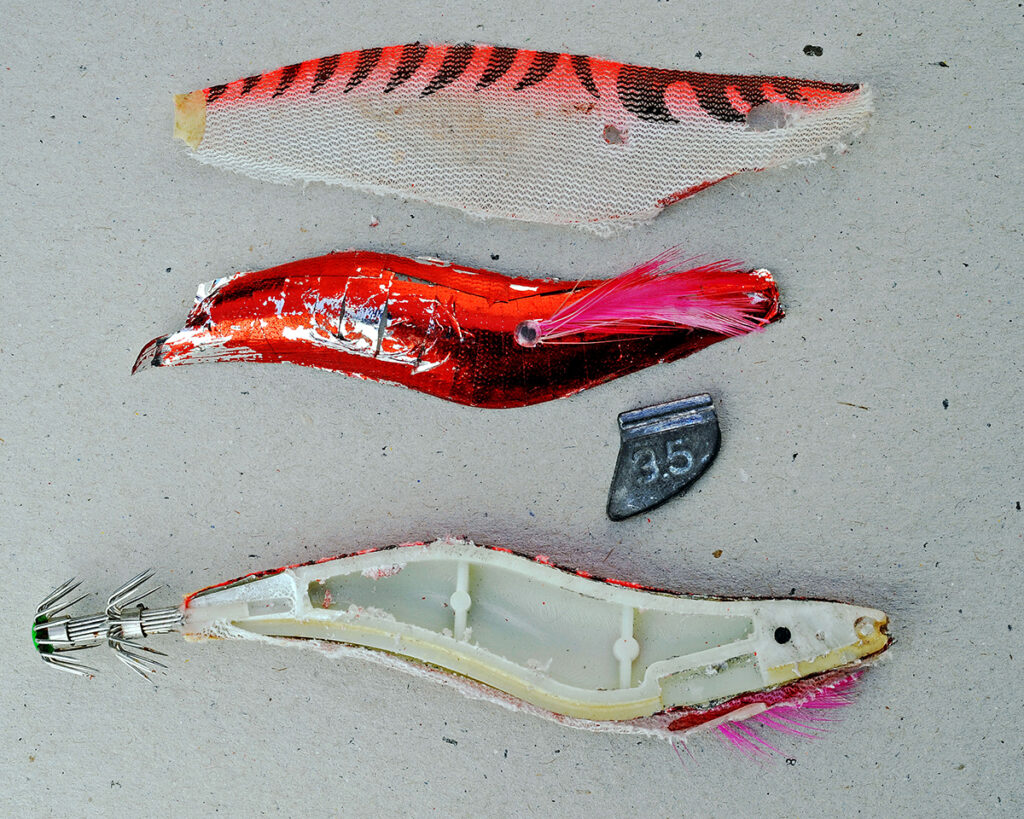
Showing the inners of shrimp-like jigs, and the weight to balance the sink and draw method.
Keep the cuttles if you want, but keep them well away from the squid, the cuttle ink is far stickier and will ruin the squid flesh. Unless I have to, I don’t even bring them aboard, and of the few that I have no option but to haul inboard, they go straight into a bucket and once the gear is back working, the cuttlefish goes back overboard. I have never had one try again. It doesn’t take long to make a squid trace. I use separations of about one metre between jigs and a snood length of 15cm.
Serious DO NOT rules
DO NOT end a day, wrap up those traces and leave them on the boat. Those jigs are not commercial jigs and the hooks bend – they are meant to bend – and a pair of long-nosed pliers is all you need to service the jigs, and that is vital.
Again, as far as the squid are concerned, you are dealing with a product of £5 to £10 per squid. Even if that jig cost you £5 or more, after catching just one squid, that jig owes you nothing. Equally, servicing will cost you nothing but time. And the same applies to the trace; replace it at least once a fortnight and if you get into a mess, and that is inevitable, DO NOT lose fishing time by untangling the trace. Bung the lot into a bucket or into a bag and do that at home. Being prepared for such screw-ups, you should have new sets available nearby.
Re-making traces may be necessary more regularly than you think. One of the few factors of squid behaviour that can be proven – the lowest jig catches the most squid – means the bottom jig either needs repairing, replacing or moving to the top of the trace. So make a new trace. Don’t just cut the snoods and change the jigs’ position, use that opportunity to better your chances against lost fishing.
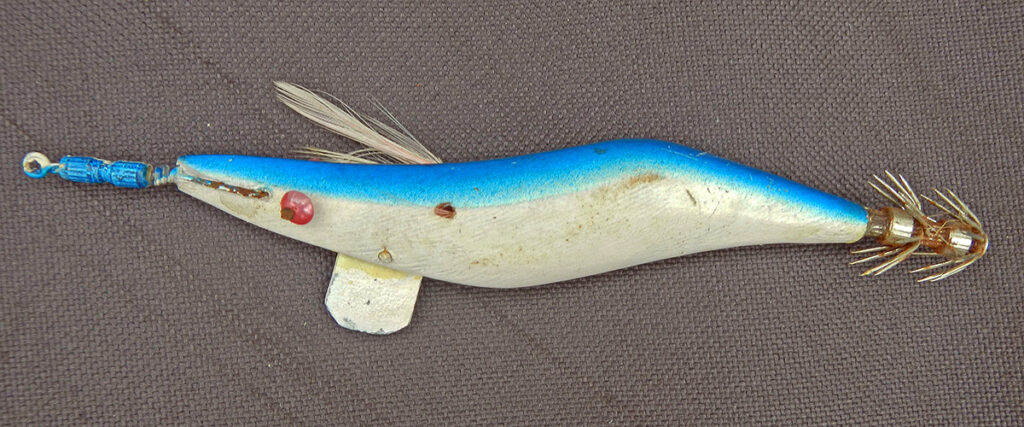
My first ever squid jig – I bought it in Sharm El Sheikh – a shrimp-like jig with a keel. I used it as a single jig on thick line and could have caught squid all through the night.
Squid are very aggressive (at least here in Falmouth Bay) and almost always attack the bottom jig first. Also, they must strike at the under-belly of that jig, because when using cloth-covered jigs that are said to be more attractive to the squid, the fabric is literally ripped apart underneath.
Whether you have a deck light or not, when in action always watch your feet, and DO NOT tread on the jig. If you do, note its position in the trace and replace it; if it is too damaged, cut it off and return to fishing. If the squid are there, they will take one of the five remaining jigs. Please refer to my pictures; even a small crack in a jig may weaken the glue attaching the hooks or the front swivel. You may not have ruined the jig but it’s better to get out the pliers and discover that at home.
DO NOT get hassled by other boats. You won’t have this problem with other commercial boats, because in all likelihood they will be engaged in their own searching or success, but here in Falmouth Bay there are a lot of leisure squidders and once they see you take a squid, they head over to you like a shot. My advice? Haul up and go elsewhere. They won’t stay long. That’s not to say that there are not true craftsmen among them, there are, but those will do their own thing.
And be gentle with the catch; always use insulated bins with just a scattering of ice. By using heavily-iced seawater you will end up with whitened squid, hardened flesh, and good chefs do not like it. Generally, fish and chip shops won’t be bothered, but you are unlikely to get £7/kg – that’s not the market you are chasing.
However, and unfortunately, many of the non-registered boats will tour restaurants and shops and either sell their squid at a ridiculously low price, or swap them for free meals, and/or beer. It’s up to you, but that should be reported to the MMO. We pay enough for our fishing licence, why don’t those skippers buy one?
And if you intend to fish the night and keep the catch over until you return to fish again the next morning, keep the night squid separate. A good chef can tell the difference. I have had embarrassing times when I have seen a buyer lay out what I thought would be OK by mixing the two types, I should not have bothered. They will pay good money but are often hard to please.
I’m sort of looking forward to writing the next piece, but ‘my’ squidding behaviour during that time, may not have been wholly Christian!
Read more features from Fishing News here.

